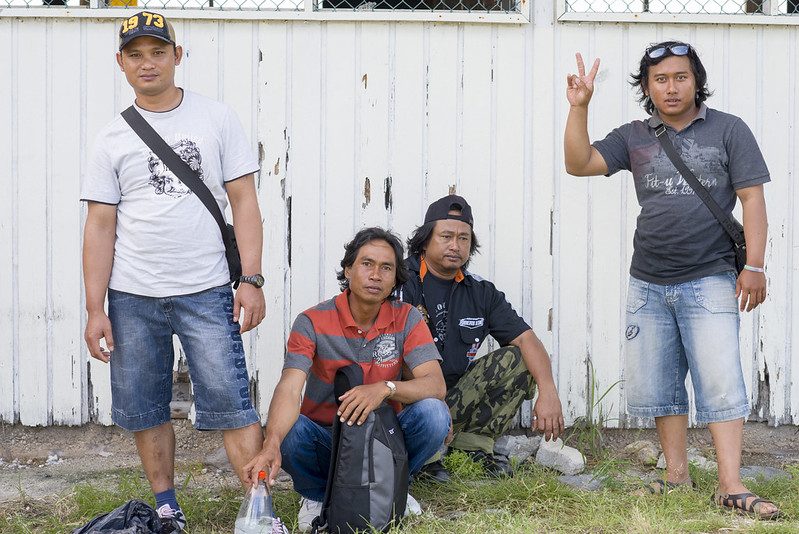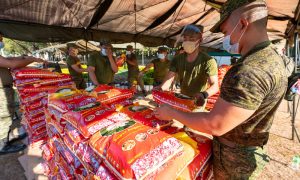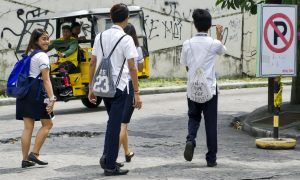In mid-2021, Abegail* received the good news that she can finally return to her job as a bartender for an Italian cruise line. It was a huge relief for the Filipino cruise worker. The previous year, she was among the thousands of Filipino migrant workers who had been repatriated to the Philippines during the initial months of the COVID-19 pandemic. With the shutdown of the cruise industry, Abegail and her co-workers spent months stranded at home, unemployed and dependent on their previous earnings to cover daily needs. “All of us have used up our savings,” she said.
Two years have passed since the World Health Organization announced the COVID-19 pandemic in March 2020. In recent months, more countries have eased border closures, lifted travel restrictions and various industries, including cruise lines, have gradually reopened. For the Philippines, a major migrant-sending country known for its model system of migration management, this meant the resumed deployment of overseas Filipino workers (OFWs). In 2021, Filipino migrant workers abroad sent home a record inflow of $31.4 billion in remittances, contributing cash fuel to local economic recovery. These recent changes seem to signal that migrant workers like Abegail can return to their jobs abroad in the ‘new normal’ and start afresh, after being stuck at home for months.
From 2020 to 2021, I was involved in a research project that documented how the COVID-19 pandemic has disrupted the Philippines’ labour export system and affected the lives Filipino migrant workers aspiring to work abroad and those who were repatriated home. In 2020, our team interviewed 45 Filipino cruise workers who were repatriated to the Philippines or whose job contracts were cancelled as the cruise line industry came to a halt. The following year, I conducted follow-up interviews with some of these cruise workers. Their stories shed light on the challenges they faced upon return and in coping with months of being stuck at home.
First, they are indicative of the pandemic’s extensive and long-term consequences for migrant workers, reminding us that beyond losing their jobs at the onset of the pandemic, they have also accumulated losses in the time they were stranded in their home country. Second, they also reveal how a crisis like the pandemic can exacerbate the challenges of return and reintegration for migrant workers, even in the case of the Philippines, which is already known for its inclusion of welfare and protection policies in migration governance. These observations raise important reflections on return preparedness and reintegration support during disrupted migration journeys.
From extended job limbo to depleted savings
The pandemic was a huge blow for the Philippines, a major source country of migrant workers and a top supplier of seafarers in the world. Official data indicate that in the first year of the pandemic alone, the number of Filipino migrant workers declined by 18.6% to 1.77 million, down from 2.18 million in 2019.
As more Filipino migrant workers lost their jobs and became stranded abroad, the Philippine government carried out a series of mass repatriations, considered the biggest operation so far in the country’s history. The unprecedented number of returning workers overstretched the country’s funds for repatriation assistance; government agencies had to seek additional funding for subsequent batches of repatriates. In 2020 alone, the Philippines had repatriated over 327,000 Filipino migrant workers—a bulk of them were working on cruise ships in Europe and North America.
Although some later found employment in call centres or online teaching, most of the cruise workers we spoke to struggled to find alternative jobs in the country, as stringent lockdowns kept many establishments closed or operational at reduced capacity.
Jeremiah, a galley steward with previous restaurant experience applied for multiple vacancies online but received no response. Restaurants in his home province and in Manila were mostly closed or were not hiring. Cruise workers like him not only had to deal with job loss abroad, but also with joblessness at home, amid a pandemic-hit economy. The uncertainty kept them waiting longer than they expected, resulting in a loss of considerable time.
Throughout the first two years of the pandemic, cruise lines were adjusting their operations and managing which workers would get to sail first. Cruise workers ended up waiting several months for an update, or their sail dates were postponed. “Always adjusting,” one interviewee said, in describing the uncertainty. “We don’t know. They can’t tell when they can give a specific [sail] date.”
By late 2021, many of our interviewees had been able to sail as the industry started to reopen. Most were grateful for their new contracts. “I was stuck here in the Philippines for eleven or ten months,” Jeremiah told me. But many of them had to accept shorter job contracts and reduced salaries. Some only received basic pay with no commissions, at least temporarily, as cruise ships were operating with few to no passengers.
Some of our interviewees had to put on hold their plans of buying properties and setting aside money for other future plans. Late last year, I spoke to Jeanette, an operations manager, who was excited to sail again after being stuck in the Philippines for nearly 17 months. She hopes to financially recover with additional job contracts so she can pay for her car instalment, and fulfil her plans of buying a home. “I’ve thought about it, to add more [years of working at sea]. Because I’ve used my savings.”
Apart from their disrupted journeys abroad, cruise workers suffered from accumulated losses over time as they spent months of prolonged strandedness at home. With months of joblessness and depleted savings, cruise workers now have to work additional contracts in order to catch up with their financial goals and derailed future plans.
Challenges in return and reintegration amid a pandemic
To help repatriated migrant workers, the Philippine government announced several forms of economic support, including cash assistance and reintegration programs such as entrepreneurship loan schemes, livelihood support, job referrals and training programs. The range of services to some extent provided options for those in immediate need and those unsure of what to next. But in their own experiences of return and reintegration, many of the cruise workers we interviewed faced challenges in claiming government assistance and venturing into entrepreneurial projects.
While most cruise workers were aware of the available government programs for migrant returnees, some were discouraged by the tedious and time-consuming application procedures. Several of those we spoke to applied for the one-time cash assistance of Php10,000 (about USD190-200), which was intended as an immediate form of post-return support. As well as spending time preparing their applications, some had to wait for as long as four to five months before they received the cash. Those who followed up with the government office were told that they would have to wait longer, as the government’s funds were running out and more had to be requested.
Eli, a cruise performer, applied for cash assistance in May 2020, shortly after he was repatriated. But he only received the money in February 2021, nearly a year later, after several calls inquiring about the status of his request. “Actually, it’s like I lost hope. I said, ‘Will I still get it?’ Because I kept calling and calling,” he told me. The pandemic may have overwhelmed the state’s funds for migrant welfare and protection, but the notable delays are also symptomatic of the existing bureaucratic hurdles that slow down the delivery of much-needed assistance for stranded migrant workers.
While appreciated, the amount of cash provided was only enough to cover a short period of time in an ongoing pandemic. They had to rely on their own resources and the support of family members for household expenses, investments and debts. With these financial concerns, few returnees could be expected to immediately jump at entrepreneurial loan programs that could fail or generate low returns. Reports suggest that many migrant workers who availed of entrepreneurship programs in the past have not been able to pay back the loans from these schemes.
Many of our interviewees pursued self-financed online businesses to cope with extended unemployment at home. They sold homemade food, baked goods and clothing online and in their neighbourhoods. While our findings do not cover government reintegration programs, the experiences of cruise workers in starting their own businesses amid a pandemic show some challenges when it comes to entrepreneurial ventures.
Clariza started an online business to cope with 11 months of unemployment. But even though she was selling a range of products—from pain relievers to bags—the earnings weren’t enough to pay the bills. Gerard, an assistant waiter for a global cruise line, attempted to start a food business, but the venture only lasted a few weeks because of difficulties finding suppliers and a lack of equipment. For other cruise workers, it was difficult to sustain a business amid rising food prices and heavy competition, as many migrant returnees started similar businesses; demand was also low as many households faced financial constraints.
Some cruise workers were able to sustain their businesses until their redeployment. But the stories we heard also show that reintegration initiatives, in this case the self-financed ones, do not always work out and can lead to more debt and lost time and resources, even more so in a pandemic.
Most interviewees said that once they received a sail update from their company, they would definitely go abroad again, as they preferred the higher salaries, the opportunity for more savings and upward career mobility. This resonates with findings from a 2021 survey by the IOM, which found that nearly half of its migrant worker respondents intended to re-migrate for overseas work. “For sure, I’m returning 101% because of the salary as well….” one cruise worker said. “Because I want to invest, to settle earlier…it’s easier if it’s [on] the cruise line.”
For many of the cruise workers, the pay reduction and shortened contract periods on cruise ships are still better than putting up with temporary, low-paying jobs at home or running online businesses that yield limited returns.
The costs of strandedness and the challenges of return and reintegration
Findings from our project suggest that the impact of COVID-19 can stretch into the long-term, exacerbating hardships for stranded OFWs. Commentaries, reports and public discourse have rightly pointed out the need to provide post-return assistance for repatriated migrant workers. Simultaneously, it is also important to consider the challenges of return and reintegration, not just in terms of government programs and services, but also in relation to broader structural factors—the conditions of the local economy before and during the pandemic, the limitations of institutional policies and programs, and bureaucratic hurdles.
The enduring preference of Filipino migrant workers to go abroad also reflects the country’s long-standing reliance on overseas remittances, which have become “a pillar of the country’s economy.” While there are more return and reintegration programs now to encourage migrant workers to invest their earnings and efforts back home, there remain questions on how policies can better support migrant workers in their return preparedness and safety nets, not just when planning to return permanently, but also in moments of disruptions. Moreover, the challenge of reintegration also leads to the question of how the country can cultivate an environment of economic opportunities that will convince them to stay or invest long-term in the country.
The Philippines’ migration system has taken strides in incorporating return and reintegration policies and programs over the years. Yet there remain avenues for improvement. These include further streamlining procedures for claiming assistance, updating reintegration services to make them less complicated and more sustainable for returnees, and to conduct research to inform policymaking. Past research, for example, has found that many OFWs have low return preparedness and are less engaged in state-sponsored entrepreneurship programs. Gathering such information to understand the attitudes and profiles of returning migrant workers are crucial for recalibrating and strengthening programs in ways that meet their needs and interests. Stronger systems of return and reintegration, in turn, can fortify existing social protection mechanisms for migrant workers not only in a pandemic, but in other future crises.
 Facebook
Facebook  Twitter
Twitter  Soundcloud
Soundcloud  Youtube
Youtube  Rss
Rss 


